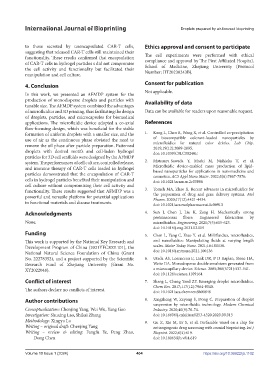Page 412 - IJB-10-1
P. 412
International Journal of Bioprinting Droplets prepared by air-focused bioprinting
to those secreted by unencapsulated CAR-T cells, Ethics approval and consent to participate
suggesting that released CAR-T cells still maintained their The cell experiments were performed with ethical
functionality. These results confirmed that encapsulation compliance and approval by The First Affiliated Hospital,
of CAR-T cells in hydrogel particles s did not compromise School of Medicine, Zhejiang University (Protocol
the cell activity and functionality but facilitated their Number: IIT20230243B).
manipulation and cell culture.
4. Conclusion Consent for publication
Not applicable.
In this work, we presented an AFMDP system for the
production of monodisperse droplets and particles with Availability of data
tunable size. The AFMDP system combined the advantages
of microfluidics and 3D printing, thus facilitating the design Data can be available for readers upon reasonable request.
of droplets, particles, and microcapsules for biomedical
applications. The microfluidic device adopted a co-axial References
flow-focusing design, which was beneficial for the stable
formation of uniform droplets with a smaller size, and the 1. Kong L, Chen R, Wang X, et al. Controlled co-precipitation
use of air as the continuous phase obviated the need to of biocompatible colorant-loaded nanoparticles by
microfluidics for natural color drinks. Lab Chip.
remove the oil phase after particle preparation. Patterned 2019;19(12):2089-2095.
droplets with desired motifs and cell-laden hydrogel doi: 10.1039/C9LC00240E
particles for 3D cell scaffolds were designed by the AFMDP
system. The performances of cell culture, controlled release, 2. Matsuura-Sawada Y, Maeki M, Nishioka T, et al.
and immune therapy of CAR-T cells loaded in hydrogel Microfluidic device-enabled mass production of lipid-
based nanoparticles for applications in nanomedicine and
particles demonstrated that the encapsulation of CAR-T cosmetics. ACS Appl Nano Mater. 2022;5(6):7867-7876.
cells in hydrogel particles benefited their manipulation and doi: 10.1021/acsanm.2c00886
cell culture without compromising their cell activity and
functionality. These results suggested that AFMDP was a 3. Tomeh MA, Zhao X. Recent advances in microfluidics for
powerful and versatile platform for potential applications the preparation of drug and gene delivery systems. Mol
Pharm. 2020;17(12):4421-4434.
in functional materials and disease treatments. doi: 10.1021/acs.molpharmaceut.0c00913
Acknowledgments 4. Sun J, Chen J, Liu K, Zeng H. Mechanically strong
proteinaceous fibers: Engineered fabrication by
None. microfluidics. Engineering. 2021;7(5):615-623.
doi: 10.1016/j.eng.2021.02.005
Funding 5. Chen L, Yang C, Xiao Y, et al. Millifluidics, microfluidics,
This work is supported by the National Key Research and and nanofluidics: Manipulating fluids at varying length
Development Program of China (2021YFC3001101), the scales. Mater Today Nano. 2021;16:100136.
National Natural Science Foundation of China (Grant doi: 10.1016/j.mtnano.2021.100136
No. 22278352), and a project supported by the Scientific 6. Utada AS, Lorenceau E, Link DR, P D Kaplan, Stone HA,
Research Fund of Zhejiang University (Grant No. Weitz DA. Monodisperse double emulsions generated from
XY2022048). a microcapillary device. Science. 2005;308(5721):537-541.
doi: 10.1126/science.1109164
Conflict of interest 7. Shang L, Cheng Yand ZY. Emerging droplet microfluidics.
Chem Rev. 2017;117(12):7964-8040.
The authors declare no conflicts of interest. doi: 10.1021/acs.chemrev.6b00848
Author contributions 8. Xingzheng W, Zeyong S, Dong C. Preparation of droplet
suspension by microfluidic technology. Modern Chemical
Conceptualization: Chenjing Yang, Wei Wu, Yang Gao Industry. 2020;40(9):70-74.
Investigation: Shuxing Lao, Shikai Zhang doi: 10.16606/j.cnki.issn0253-4320.2020.09.015
Methodology: Xingyu Lu 9. Gu Z, Xie M, Lv S, et al. Perfusable vessel-on-a-chip for
Writing – original draft: Chenjing Yang antiangiogenic drug screening with coaxial bioprinting. Int J
Writing – review & editing: Fangfu Ye, Peng Zhao, Bioprint. 2022;8(4):619.
Dong Chen doi: 10.18063/ijb.v8i4.619
Volume 10 Issue 1 (2024) 404 https://doi.org/10.36922/ijb.1102

